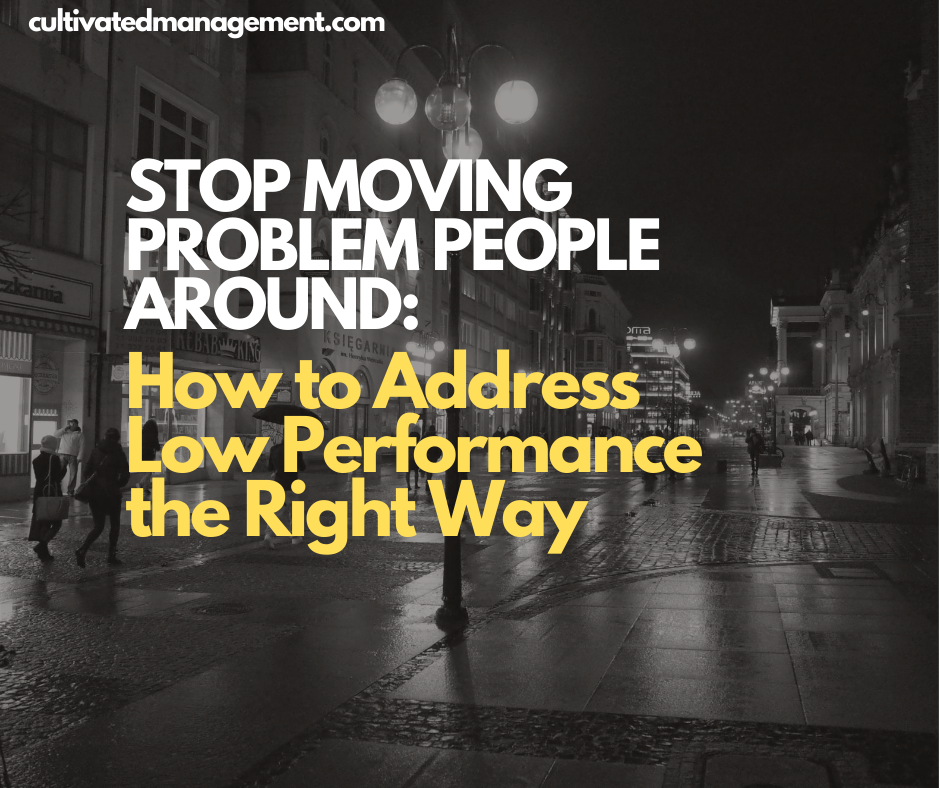Stop Moving Problem People Around: How to Address Low Performance the Right Way
Moving under-performers around doesn’t solve the problem. Learn practical steps to address low performance, give effective feedback, build coaching plans, and retain high performers while improving the system.

The other month, I was speaking with a group of high-flying execs who were talking about how they often have to move low-performing people around.
One thing was super clear – a lot of people still do this: “moving problem people around.” Low performers are simply shifted to other teams rather than managers addressing the issue directly.
I remember a talk about five years ago where a senior exec admitted they did the same when transitioning to agile. Anyone who didn’t “get it” was moved elsewhere. What surprised me most was the cheering and nods of approval. This was seen as a victory.
In another company there was an entire department of low performer who have all been moved together in a single team – with no clear objective, nor value add work to do.
Let's get one thing really clear – this is inhumane and unfair. It is not a Victory to simply move someone around and pass the burden.
It is not fair on the individual, nor other managers, nor other employees, nor the investors or shareholders, nor the customers.
Low performance should be dealt with carefully, with humility, with empathy and with clarity.
How to deal with low performance
- Give clear feedback – Focus on behaviours, not personalities or opinions. Explain which behaviours are below the standard – this assumes you have a standard – if not, start there. Many employees underperform simply because they’ve never been told what “meeting the bar” looks like.
- 👉 The free 10 Behaviours of Effective Employees is a good place to start defining what good looks like – and setting the standard
- Document everything – Take notes of feedback, coaching sessions, and performance conversations. These records protect both the business and the employee if escalation is needed.
- Good luck going to HR about a low performer if you've never had a conversation with the person about behaviours – nor captured any coaching or improvement ideas.
- Build a coaching plan – Provide resources, learning opportunities, and guidance to help them meet the expected standard. Spend more time with high performers to retain and grow them, but don’t neglect under-performers.
- 👉 Everyone needs a coaching plan
- Escalate when necessary – If performance doesn’t improve, engage HR for a formal performance improvement plan. Most HR teams will support you if you’ve done your due diligence.
- Be empathetic – Removing someone from a business has real-life consequences: bills, families, responsibilities. It should be a last resort, handled carefully and fairly. Avoiding this process by moving people around benefits no one.
As Paul Hawken said in Growing a Business (aff link) :
"Firing is failure. Everybody is at fault. That's the simplest way to look at it. The best way to avoid firing people is to hire well in the first place.
Hiring is one of the most critical activities in any business, and you should learn to do it well. It can make an enormous difference to your success.
I estimate that one-half of all business problems originate with the perceptions, attitudes and practices of the owner. The other half of the problems are caused by faulty hiring." (Hawken, 1988)
Solve the problem completely
Solving problems in their entirety is the fastest way to unblock systemic issues. Don’t pass the burden to another team or manager. Address low performance head-on, in partnership with HR and other stakeholders.
Focus on your high performers
Remember Edward Deming: 94% of success comes from the system. Spend the majority of your time fixing systemic issues — processes, communication, workflow. Then invest your remaining time in people, with an emphasis on your high performers. They’re the ones who drive results and retain talent.
Bottom line
Most “under-performers” have never been told they’re falling short. Start there. Be honest, constructive, and empathetic. Address the problem directly. Build a culture where managers own challenges rather than passing the burden.
Management is hard — but that’s why we signed up for it. It’s not about avoiding tough conversations or moving people around. It’s about nudging both people and the business in the right direction.
👉 Ready to move faster towards your business goals while building a workplace people love? I help managers and leaders get there—through coaching, consulting, and training. See how I can help you.